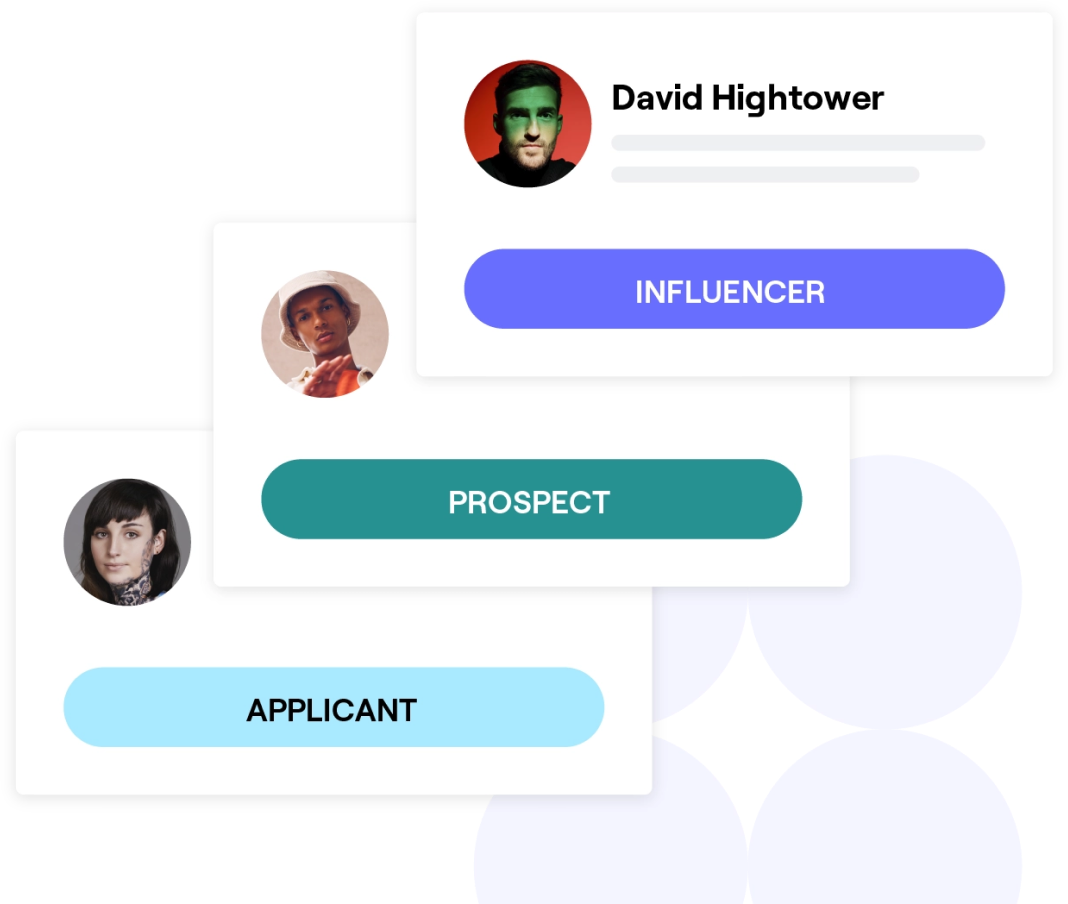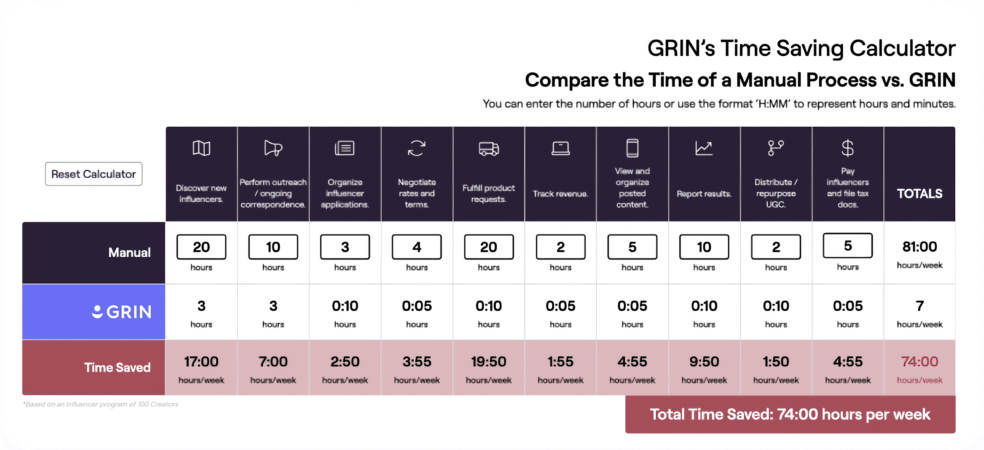Negotiating with content creators and identifying a fee structure is often one of the most challenging parts of scaling your influencer program. Without experience, it can be difficult to know whether your creators are overcharging.
Establishing your fee structure doesn’t have to be an awkward conversation between you and your creators, though. Rather, it can become a way to demonstrate to your creators what your expectations are and how you intend to reward them for their efforts.
6 Common factors that affect influencer rates in 2023
1. The size of their following
Many marketers group influencer types by the number of followers they have. These categories include:
- Nano influencers (1,000-10,000 followers)
- Micro influencers (10,000-100,000 followers)
- Macro influencers (100,000-1 million followers)
- Mega/celebrity influencers (1 million or more followers)
As a general rule, the more followers a creator has, the more expensive they will be. But before you assume someone with 500,000 followers is worth a high flat rate per post, it’s critical that you examine the quality of their engagement.

2. Their engagement rate
Many creators set their rates based on their follower count. And while follower count can be a measurement of potential reach and popularity, it’s not the whole picture.
Audience engagement is a strong indicator of a creator’s ROI. This is a critical metric for determining the quality of relationships creators maintain with their audiences.
When a creator has strong engagement metrics, they generally have greater connections with their followers. As a result, their audience is more likely to trust the creator’s product recommendations and industry advice.
To gain insight into a creator’s engagement rate, perform a “deep dive” through their posts to determine the quantity and quality of their follower engagement. Look for meaningful comments, relevant shares, and ongoing user-generated content initiated by that creator’s posts.
Try Our Tool: Analyze any influencer on YouTube or TikTok
3. The platform the content lives on
In general, the platform that the content will live on depends on what type of content you need in the first place. For example, if a brand wants an Instagram post, the creator may need to develop a short reel, a story, or a photo post, while a YouTube request would require a longer video.
In general, long-form videos and blogs require the most time to produce and thus require larger fees.
Each platform has a general formula for determining base rates. Of course, these are just estimates, and you should review them on a case-by-case basis.
Let’s dive into some of the most common platforms.
TikTok influencer rates
According to Neal Schaffer, a marketer can determine the general rate for a TikTok content creator with the following formula:
25 x (number of followers/1,000) = $ rate per post
Instagram influencer pricing
For a single image Instagram grid post, a general formula to follow is:
10 x (number of followers/1,000) = $ rate per post
However, if you’re looking for a story or reel that more closely resembles a TikTok video, use the TikTok formula to account for the extra content production requirements.
YouTube influencer rates
There are a couple of elements that can impact a YouTube video’s cost, including the length of the video and whether the entire video is about a brand’s product or it is merely a mention in a video largely about something else.
In general, we recommend using the TikTok formula again, but if the content ask is much longer (5+ minutes), brands should increase the overall rate.
Blog pricing
Since blogs can take a much longer amount of time, the rate for one of these posts is generally much higher. Again, according to Neal Schaffer, an ideal formula for a blog post may be:
60 x (number of unique visitors/1,000)= $ rate per post
4. The type of relationship between the brand and influencer
The nature of each influencer campaign can also impact how much a creator’s participation is worth.
For example, your evergreen creators (those you use regularly) produce content at a higher volume than your seasonal or one-off campaign content creators. As such, it’s appropriate for your evergreen creators to be on a different pay structure than those who are seasonal.
5. Content usage rights
Gaining permission to use a creator’s content on your own social accounts or in other marketing efforts will require a larger investment. There are a few main factors that will determine how much the cost increases when it comes to gaining content rights:
- How long the brand will use the content
- What platforms and media the brand will use the content on
- Whether the brand can alter the content in any way
6. Influencer perks
Depending on your brand and its deliverables, you may be able to offer partners several attractive perks. Many will lower their rates in exchange for samples, gifts, and special experiences.
Creating great perks is one of the best ways to prepare for creator negotiations. But in order for your perks to be enticing, you need to know as much about your potential partners as possible. Just because you or another creator thinks one thing is a great perk doesn’t guarantee that it will be to another person.
What are the different ways brands pay influencers?
1. Free products
Product exchange, also known as product seeding, is a compensation strategy that includes no cash transactions. In a product exchange, creators accept free products and samples for promoting your brand.
This approach is the most cost-effective since hiring a creator is only as expensive as the cost of goods sold.
Another great benefit of product exchange is that partners who accept this compensation structure do so because they truly love your brand. That often means your campaign guarantees authenticity and social proof.
Creator types that appreciate free products in exchange for social media posts include:
2. Pay per post (flat fee)
As the name implies, a pay-per-post arrangement requires you to pay a flat fee per creator post. The cost of each post may vary from less than $10 to thousands of dollars.
Before you pay that kind of money, you will need some assurances of a creator’s ROI. However, there are some key scenarios in which paying for each post may be your best approach.
One such scenario occurs when you have a creator that you’ve worked with for some time, and they consistently create content that is more artistic than anything you can produce in-house. Because this brand-creator relationship is strong, you can verify ROI before payout. Furthermore, those posts are great for repurposed content in paid ads, email, and more (production costs that you would have had regardless).
Another common scenario in which a pay-per-post arrangement may be ideal occurs when you want to partner with influencers that have massive, engaged audiences. Before you invest in these macro and mega influencers, it’s important to check the quality of their engagement. Because of how popular they are, it won’t be possible for them to respond to every follower comment, but you should see meaningful conversations taking place within the comments of their posts.
A pay-per-post arrangement is most common among influencers with 10,000 or more followers, including:
- Micro influencers
- Macro influencers
- Mega/celebrity influencers
3. Commission
For brands whose primary measure of ROI for influencer marketing is revenue, commission-based payments can be an excellent way to track sales and encourage content creators to develop conversion-worthy content.
Brands can measure sales and keep track of commission through:
- Affiliate links. These are specific URLs designed for your chosen creator containing a custom affiliate ID and username. The creator advertises their link, along with an incentive like a discount or free product, for the audience members to click when promoting your brand’s product or service.
- Discount codes. These are similar to affiliate links, given that they are specific to each partner. Creators can promote their discount code on their social media posts when talking about your company’s products or services, and the audience can apply this code at checkout to receive money off their orders or some other perk.
Discover GRIN’s Capabilities: Affiliate Marketing Management
But there can be a downside to using commissions to pay your partners—some content creators may lose their authentic edge and begin to come across as “salesy.”
Seasoned creators know how to balance high conversion tactics with authenticity. If you’re going to use affiliate marketing techniques, make sure to choose your team wisely.
Marketers who use commissions as their preferred compensation package typically work with:
- Affiliates
- Brand ambassadors
- Nano influencers
- Micro influencers
4. Combining payment methods
As your creator management program grows, you’ll most likely need to use a combination of all payment types. The more experience you have with these compensation packages, the easier it will be for you to negotiate successfully with potential partners.
What’s critical to keep in mind is that knowing your content creators well will keep your partnership from being transactional.
Treating them as true partners and offering them perks that you know they’ll enjoy will strengthen the relationship, leading to amazing content and the potential for lower costs.
And if cash payments are your main way of rewarding creators, having this established communication keeps the content authentic.
But the moment you lose sight of that relationship dynamic is the moment “the doldrums” of inauthenticity begin to set in. The success of your influencer program relies primarily on the genuineness of your creators. Consumers can tell when someone is only in it for the money.
See Also: How Do Creators Want to Be Paid?
Talking to influencers about rates
Compensation is one of the most important topics during creator negotiations. Because these talks with a new person can be awkward, it’s important that you initiate the conversation by asking them about their rates.
“I always make sure to ask influencers their number because we can work backwards from there.”
– Ethan Frame, Director of Brand and Special Projects at Cuts Clothing, via the 0-100 Webinar – Chapter Three: Influencer Budget
If a creator’s rates are more than your budget, that doesn’t necessarily mean that they won’t work with you. It’s essential to get to know them and establish a mutually beneficial working relationship. Expensive creators will sometimes lower their rates for fewer posts or additional perks.
Tax considerations when working with influencers
Whenever cash flows in and out of your business, you need to record it for taxes. Your bookkeeping needs to include payments made to partners, product exchanges, and relevant contractor expenses.
Independent contractor (cash payments)
Whenever you pay a content creator in cash, you’ll need a completed W-9 so you can file a 1099 for them. The only exception is if you paid them less than $600 in any given year.
Produce/service barter (product exchange)
A product exchange is technically bartered services. The IRS requires businesses to record any income generated from barter transactions in a 1099-B form. Your influencers should also complete a 1099-B form when filing their taxes.
Tax-deductible expenses (influencer perks)
If you offered any partner perks that cost you money, you might be able to claim them as operating expenses. When itemizing these costs to lower your tax liability, make sure to confirm all expenses with an accountant or business attorney before filing your taxes.
Making influencer taxes easy
It can be easy to get overwhelmed by W-9s and 1099s for all of your content creators, especially if you’re working with a large group each year. See how GRIN can handle tax documentation for you, giving you time to focus on what really matters.
Key takeaway: There is no set price to pay influencers.
When it comes to negotiating with content creators, the fact of the matter is that there are so many factors that can affect price, so trying to set one fixed rate can lead to frustration.
And like anything in life, determining creator compensation packages will become easier with experience. Armed with your marketing priorities and performance data, your creator fee structure will take shape. And in time, you’ll be able to tweak your budget to boost results and grow your brand.
Learn more about influencer marketing: Influencer Marketing 101

















